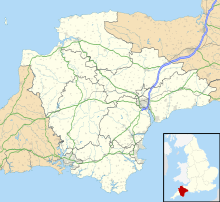Birch Tor and Vitifer mine facts for kids
 |
|
| Location | |
|---|---|
| Location | Dartmoor |
| County | Devon |
| Country | England |
| Coordinates | 50°36′43″N 3°52′05″W / 50.612°N 3.868°W |
| Production | |
| Products | Tin |
| History | |
| Opened | 1750 (approx) |
| Closed | 1925 |
| Owner | |
| Company | Various |
The Birch Tor and Vitifer mine was an important tin mine located on Dartmoor, in Devon, England. It was found in the valley of the Redwater Brook. This area is east of the B3212 road that goes from Moretonhampstead to Princetown. The mine operated for many years, from the mid-1700s until 1925.
Contents
History of the Mine
For hundreds of years, even before the mine officially started, this area was a busy place for digging. People used to dig for tin right on the surface. Today, you can still see the marks left behind. There are big piles of waste rock from "stream working." This is when miners dug for tin in riverbeds. You can also see deep gullies from "open cast mining." This means digging a large open pit from the surface.
Two Mines, One Management
Even though they are often talked about together, Birch Tor mine and Vitifer mine were technically separate. Birch Tor was on the east side of the Redwater Brook valley. Vitifer was on the west side. However, for most of their active years, they were run by the same people. This is why they are usually considered one big mining operation.
The Vitifer Mine was first mentioned in official records around 1750. Birch Tor Bounds, which refers to the Birch Tor area, appeared in records in 1757. By the 1780s, the Dartmoor Mining and Smelting Company was running Vitifer. In 1796, about 40 men worked there.
Early Operations and Challenges
A few years later, the mine had a large water wheel. This wheel was 36 feet (11 meters) tall. It was used to pump water out of the mine. The mine also had a long tunnel called an adit. This tunnel was half a mile long and took almost four years to dig. It helped drain water from the mine.
At first, the tin ore from the mine was sent to Cornwall. There, it was "smelted," which means melting the ore to get the pure tin metal. But by the 1820s, the ore was smelted closer to home. This happened at Eylesbarrow mine, also on Dartmoor.
In 1834, the mine was doing well and making money. However, the working conditions for the miners were very tough. More than 100 people worked there, including women and children. The places where they lived were very poor. Miners often had to share beds because there wasn't enough space. This meant beds were used all day and night. The air quality underground was also very bad. Miners often got sick due to these harsh conditions.
Growth and Decline
By 1838, Birch Tor mine had two large waterwheels, each 40 feet tall. It also had another 32-foot wheel. At this time, it was the only big mine working on Dartmoor. In 1845, the two mines, Birch Tor and Vitifer, officially joined together. Two 45-foot waterwheels were then used to keep the underground tunnels dry. Around this time, miners found that the deeper they dug, the less tin they found. This was different from many mines in Cornwall, which often found more tin deeper down.
By the 1850s, only about 20 men were working at the mine. But by 1863, the mine became busy again. About 150 people were employed there. The mine's best year was 1864. It sold 150 tons of "black tin," which is a type of tin ore. In 1870, 102 people still worked at the mine. However, it was closed down in 1882.
Later Years and Final Closure
From 1887 to 1903, a small amount of mining continued. Moses Bawden, who had worked at the mine since the 1860s, led this effort. Then, from 1903 to 1913, new owners, Phelips and Padfield, kept about 20 miners working each year. This was the last time underground mining happened at Birch Tor and Vitifer.
After that, people continued to search for tin in the old waste piles. This "reworking" of the dumps continued until 1925. Some more work on the dumps happened in 1938-1939. However, there are no records of any tin being produced during that last period.


